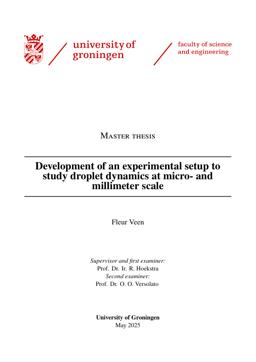2025-05-15
Development of an experimental setup to study droplet dynamics at micro- and millimeter scale
Publication
Publication
The deformation of droplets after laser impact has recently gained more interest because of its application in EUV nanolithography machines. In the source of these machines, a laser pulse is fired at liquid tin droplets to deform the droplet into a suitable target for plasma generation. The droplet deformation process is studied extensively, by using a combination of shadowgraphy and stroboscopic imaging techniques. However, the high refractive index of tin does not allow for the visualization of pressure fields inside the droplet, something a transparent medium like water does allow for. Due to dynamic similarity in fluid flows, the droplet deformation of water can be compared to tin if non- dimensional parameters like the Weber number are the same. This thesis describes the development of two experimental setups, which can be used to visualize droplet deformation at the micro- and millimeter length scale. First an experimental setup at millimeter scale is designed, to evaluate methods for studying water droplet deformation, where water droplets are deformed by impact on a similar sized pillar. The setup is characterized in terms of droplet size and droplet velocity, giving a Weber number range of 50 – 550. Then a setup at micrometer scale is designed, where microdroplets are generated using a piezo-actuated droplet-on-demand system, operated in negative pulse voltage mode. Characterization results show the system can produce droplets in a diameter range of d = 83 – 100 μm, with velocities of vd = 0.9 – 2.2 m/s, depending on the liquid properties and generator settings. Due to the low Weber number of droplet impact on a pillar, its radial expansion is limited, resulting in oscillation of the droplet. In an outlook, a vacuum setup is briefly introduced, which can allow for future studies of droplet deformation at micrometer scale in a low pressure environment.
| Additional Metadata | |
|---|---|
| R. Hoekstra (Ronnie) , O.O. Versolato (Oscar) | |
| University of Groningen | |
| Organisation | Ion Interactions |
|
Veen, F.L. (Fleur). (2025, May 15). Development of an experimental setup to study droplet dynamics at micro- and millimeter scale. |
|

